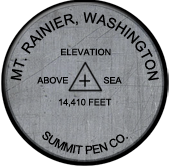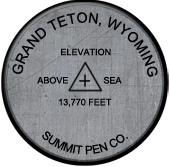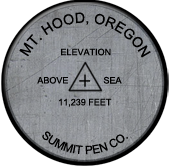Mount Rainier
14,411 - Washington
Summit Pen Company Iconic American Peaks > Mount Rainier
Mt. Rainier - An Iconic American Peak and part of the Summit Pen Company Iconic American Peaks Collection
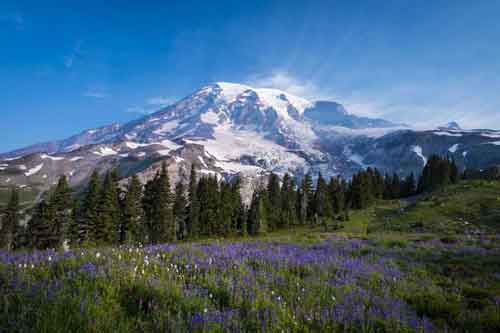 Mount Rainier has captured the imaginations of courageous men and women for more than 150 years. Visible from points throughout the Pacific Northwest as far away as Portland, Oregon and Victoria, British Columbia, Rainier also looms large in the minds of climbers and adventurers. From the earliest explorers of the region to the modern climber today, people have been drawn to Rainier for the same reasons – they are attracted by the majesty and tranquil beauty of the mountain, and simultaneously are drawn in by the mountain's harsh environment and the opportunity to test one's character and physical stamina.
Mount Rainier has captured the imaginations of courageous men and women for more than 150 years. Visible from points throughout the Pacific Northwest as far away as Portland, Oregon and Victoria, British Columbia, Rainier also looms large in the minds of climbers and adventurers. From the earliest explorers of the region to the modern climber today, people have been drawn to Rainier for the same reasons – they are attracted by the majesty and tranquil beauty of the mountain, and simultaneously are drawn in by the mountain's harsh environment and the opportunity to test one's character and physical stamina.
The first explorers of the peak's glaciers faced an unknown challenge when they set out to climb Rainier. The approach to the mountain itself was harrowing; the first mountaineers in the area forged trails through dense forests along the Nisqually River for days just to reach the glacier. Once on the glacier, the crevasses, caves and snowfields they encountered were uncharted terrain. What's more, the peak was steeped in superstition and lore -- the native Chinook people warned early explorers of Tacoma, a wrathful, fiery demon said to live at the peak's summit. In spite of these challenges – physical and psychological – Rainier's early explorers persevered. Over time, each success buoyed the aspirations of another team of climbers, and the mountain was slowly explored and mapped. Today there are around sixty routes to the summit, but most climbers ascend routes via Camp Muir on Rainier's southeast flank.
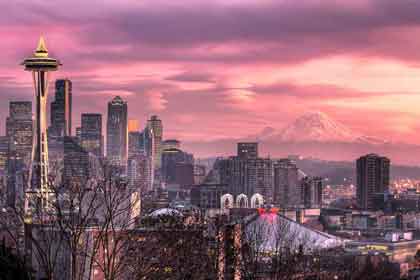 The lore and the mystery of Rainier have long since eroded – today 9,000-13,000 climbers attempt Rainier each year, and about half of those reach the summit. Yet the modern climber still faces both physical and psychological challenges. Climbing Rainier means exposing oneself to objective hazards like crevasses and rock fall, as well as the threat of inclement weather. A summit attempt on the mountain can provide a true test of a climber's physical stamina and mental focus. The mountain has tested many, and those who have summited belong to an elite club of adventuresome and courageous men and women. Despite the effort, risk and suffering that are a part of every summit experience, or perhaps because of those factors, summiting Mount Rainier is a sought-after and rewarding experience.
The lore and the mystery of Rainier have long since eroded – today 9,000-13,000 climbers attempt Rainier each year, and about half of those reach the summit. Yet the modern climber still faces both physical and psychological challenges. Climbing Rainier means exposing oneself to objective hazards like crevasses and rock fall, as well as the threat of inclement weather. A summit attempt on the mountain can provide a true test of a climber's physical stamina and mental focus. The mountain has tested many, and those who have summited belong to an elite club of adventuresome and courageous men and women. Despite the effort, risk and suffering that are a part of every summit experience, or perhaps because of those factors, summiting Mount Rainier is a sought-after and rewarding experience.
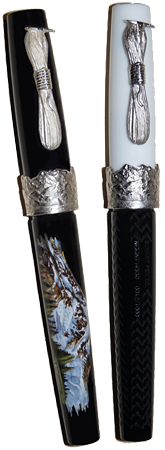 The modern Mount Rainier adventurer is much the same as mountain's early climbers. Rainier attracts individuals who would rather do than observe, and for whom the suffering of a climb is more meaningful than the pretty view of the mountain from a distance. The people who find the courage and gumption to climb a mountain like Rainier know that climbing makes them a better person. Climbers say that time spent on the mountain makes them feel free, brings clarity, and provides a ground for testing oneself. Whereas the first explorers of Mount Rainier traveled through unmapped terrain and encountered unknown challenges, climbing Mount Rainier today takes the modern climber to uncharted parts of themselves, providing opportunities for personal growth and accomplishment. We don't climb because it's fun, beautiful or easy (though some climbers have those types of experiences on Mount Rainier). We climb because it tests who we are, and shows what we are made of. In this way, Mount Rainier climbers have not changed a bit over time. We carry on the legacy of Mount Rainier's earliest explorers.
The modern Mount Rainier adventurer is much the same as mountain's early climbers. Rainier attracts individuals who would rather do than observe, and for whom the suffering of a climb is more meaningful than the pretty view of the mountain from a distance. The people who find the courage and gumption to climb a mountain like Rainier know that climbing makes them a better person. Climbers say that time spent on the mountain makes them feel free, brings clarity, and provides a ground for testing oneself. Whereas the first explorers of Mount Rainier traveled through unmapped terrain and encountered unknown challenges, climbing Mount Rainier today takes the modern climber to uncharted parts of themselves, providing opportunities for personal growth and accomplishment. We don't climb because it's fun, beautiful or easy (though some climbers have those types of experiences on Mount Rainier). We climb because it tests who we are, and shows what we are made of. In this way, Mount Rainier climbers have not changed a bit over time. We carry on the legacy of Mount Rainier's earliest explorers.
Whether you're on your own or with a guide, climbing Mount Rainier provides a formidable test of strength and endurance. Climbing Mount Rainier is an experience that cannot be forgotten; it becomes a part of who we are and we leave the mountain as stronger people. The Mount Rainier pen commemorates the long history of exploration and climbing on Rainier, and celebrates the men and women who have tested their stamina and character by attempting the summit. Reaching the summit of Rainier means sharing in the collective history of all those who have pushed their limits on the mountain. The Mount Rainier pen can help you to share your experience on the mountain with others, representing your accomplishment and affirming your future aspirations.
Mount Rainier History
The first group that attempted to climb the upper reaches of the mountain was led by Lieutenant August Kautz in 1857. Relying on a native guide named Wah-pow-e-ty, the team bushwhacked through dense forests, following the path of the Nisqually River until they reached the glacier. A portion of the team spent two days on the glacier, reaching a high point near the summit before turning back on their 8th day of travel. While this effort is not considered the first true ascent of the mountain, it made the feat seem attainable, if barely so, for the first time. The group ran out of food on the tenth day of their expedition and did not reach civilization for another four days.
At last, after two weeks of travel, the team reemerged, "Haggard and sunburnt, [and] nearly every familiar feature had disappeared." Emaciated and exhausted, the team must have been an alarming sight. Kautz had lost his hat along the way, and had made a "headdress" out of the sleeve of a red flannel shirt. The doctor in the group had lost a pant-leg and made a new one from a coffee sack. As a result of their lack of food and water, as well as the extreme exertion of their expedition, most of the men in Kautz's group fell ill for several months. Kautz felt another summit attempt in the near future was unlikely: Only when, "American enterprise has established an ice-cream saloon at the foot of the glacier . . . attempts to ascend that magnificent snow-peak will be quite frequent," he predicted.
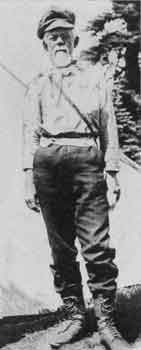 In fact, it was not until 1870 that another team attempted Rainier and the first successful ascent was made. Led by General Hazard Stevens, who recruited his friend Philemon Beecher Van Trump, among others, the party set out from Olympia, followed the Nisqually River to an Indian camp where they secured the services of a native guide named Sluiskin, and ascended to the top of Paradise Valley. Sluiskin, who warned the climbers that a "mighty chief dwells upon the summit in a lake of fire," would go no further, believing the men were climbing to their death by attempting the summit. Only Stevens and Van Trump ventured further, and they did achieve the summit after eleven harrowing hours of climbing. The day was far too advanced to consider descending before the night had passed, and the steep snowfields, cliffs and crevasses made a safe descent in the dark impossible. The men likely would have died of exposure at the summit that night were it not for a lucky break. In ascending the "middle" or true summit, the men smelled sulfur and came across warm steam vents. They took shelter in a large cavern under the ice created by the steam whose roof was a dome of green icicles. They passed a "most miserable night, freezing on one side and in a hot steam-sulphur-bath on the other," as Stevens described. Stevens and Van Trump made the first successful ascent of Rainier on August 17, 1870.
In fact, it was not until 1870 that another team attempted Rainier and the first successful ascent was made. Led by General Hazard Stevens, who recruited his friend Philemon Beecher Van Trump, among others, the party set out from Olympia, followed the Nisqually River to an Indian camp where they secured the services of a native guide named Sluiskin, and ascended to the top of Paradise Valley. Sluiskin, who warned the climbers that a "mighty chief dwells upon the summit in a lake of fire," would go no further, believing the men were climbing to their death by attempting the summit. Only Stevens and Van Trump ventured further, and they did achieve the summit after eleven harrowing hours of climbing. The day was far too advanced to consider descending before the night had passed, and the steep snowfields, cliffs and crevasses made a safe descent in the dark impossible. The men likely would have died of exposure at the summit that night were it not for a lucky break. In ascending the "middle" or true summit, the men smelled sulfur and came across warm steam vents. They took shelter in a large cavern under the ice created by the steam whose roof was a dome of green icicles. They passed a "most miserable night, freezing on one side and in a hot steam-sulphur-bath on the other," as Stevens described. Stevens and Van Trump made the first successful ascent of Rainier on August 17, 1870.
Later that same year, the second ascent was made by S.F. Emmons on behalf of the U.S. government. Emmons explored the mountain's glaciers, summit, volcanic craters and caves, and prepared the first scientific report of the topography and geology of the mountain. No other ascents were recorded during the 1870s, but the 1880s saw a number of successful ascents as well as a considerable amount of exploring and mapping of the mountain. Many of the famed sections and most popular routes on the mountain were established during this surge of exploration. When John Muir climbed Rainier in 1888, his party camped in a sheltered area amidst the glaciers that came to be known as Camp Muir. Among others, Muir was an advocate of creating a national park at Mount Rainier. In 1899, Mount Rainier National Park was established to protect the mountain and its environs for generations to come. The 1890s saw the first female ascent by Fay Fuller. Several of Fuller's male counterparts reportedly offered to aid her, but Fuller refused their help, preferring to reach the summit under her own power just as any other climber was expected to do. Fuller and her party spent an uncomfortable night upon the summit of Mount Rainier and made a harrowing descent the following day. Fuller went on to champion the efforts of women climbers through helping to found the Washington Alpine Club and the Mazamas.
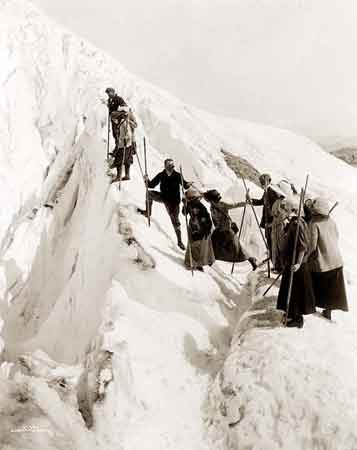 This period of exploration diminished the mountain's mystery and brought climbing into the public awareness. Large groups began to make ascents of the mountain, including the Mazama Club, the Sierra Club and the Mountaineers, making Rainier accessible to more and more people. While relatively small numbers of people were attempting the summit at this time, the public was enthusiastic about the pursuit. After a successful ascent in 1894, one climbing party consisting of thirteen men and women dressed in mountaineering attire and led by Ingraham, paraded down the streets of Tacoma chanting, "We are here! We are here! Right from the top Of Mount Rainier!" When a group such as this returned from climbing Rainier, they were met by fans and admirers.
This period of exploration diminished the mountain's mystery and brought climbing into the public awareness. Large groups began to make ascents of the mountain, including the Mazama Club, the Sierra Club and the Mountaineers, making Rainier accessible to more and more people. While relatively small numbers of people were attempting the summit at this time, the public was enthusiastic about the pursuit. After a successful ascent in 1894, one climbing party consisting of thirteen men and women dressed in mountaineering attire and led by Ingraham, paraded down the streets of Tacoma chanting, "We are here! We are here! Right from the top Of Mount Rainier!" When a group such as this returned from climbing Rainier, they were met by fans and admirers.
While detailed records are lacking for the number of ascents made during the first half of the twentieth century, it is clear that more and more people took on the challenge of summiting the mountain. The largest recorded group ever to climb Rainier reached the summit in July of 1910. The party was led by the Seattle-based Mountaineers, and consisted initially of 100 people. The participants took part in a mountaineering boot camp of sorts, spending ten days travelling across glaciers, scree and snow fields to learn mountaineering skills and build strength for the climb. Ultimately, 62 climbers were selected for the summit team, and the entire team made a successful ascent.
Early climbers did not tread particularly lightly on Rainier. In addition to climbing in large parties, it was commonplace for mountaineers at this time to fell trees for use as tent poles, and to leave garbage and human waste behind. It was not until late in the twentieth century when human impact studies were conducted that modern conservation practices were adapted. Today, regulations limit the number of climbers that may camp together in one site in order to lessen human impact on the ecosystem, and climbers must pack out their waste.
The first cars were driven into Rainier in 1910, and from that time forward, access to the park steadily improved. Roads were expanded, and winter plowing commenced. Access to the park during the winter made skiing possible, and growing numbers of skiers came to enjoy the 600+ inches of snow that fell on Rainier each year. By the late 1930s Paradise Valley was host to ski races and even the 1935 U.S. Olympic trials and National Championship for downhill skiing and slalom. Newsreels brought moving images of Paradise skiing to viewers throughout the country and Rainier attracted more skiers than ever before. The winter of 1937-38 heralded the installation of the first ski lift, which skiers paid $1 to ride for the day. By the end of the 1930s, an estimated 100,000 people visited Rainier to ski each year.
Just as quickly as skiing became popular at Rainier, WWII brought recreational skiing largely to a halt in the early 1940s. However, the ski slopes did not go unused during the wartime years. Recognizing the need for skilled ski troops, the military began ski training programs throughout the country. In November of 1941, just before entering the war, the United States created the 87th Infantry Mountain Regiment out of Fort Lewis, Washington. Ski teachers and mountaineering guides, recruited from New Hampshire and Yosemite, found no snow at Fort Lewis. They quickly moved their operations to Paradise at Mount Rainier, leasing lodges there to accommodate their growing numbers.
Men flocked from all over the country to join the ski troops. As images of tan soldiers skiing Paradise in white camouflage circulated, even the sons of the rich and famous signed up to become mountain troops. More like ski school or even summer camp than military training, the men staged mock battles in their white camouflage, posed for photographers, summited the peak during the warmer months, and even formed a glee club. Through their extensive skiing and climbing instruction at Paradise and later in Colorado, the troops were well prepared to fight in the Alps. The training of the ski troops is said to have heralded the popularity of mountaineering in the United States in the post-war years.
When the war ended, climbers and skiers returned to Rainier. A few hundred attempted to summit the mountain each year at the end of the 1940s. By the early 1960s, more than 1000 climbers attempted Rainier annually – and more than half of them were successful. Their increasing numbers led to the development of greater infrastructure in the park. Roads were improved, lodges expanded, and regulations on climbers increased.
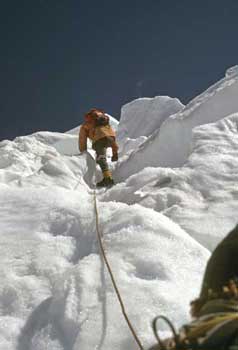 Rainier was once again brought into the public eye when the mountain was used as a training site for the American Mount Everest expedition of 1963. Jim Whittaker, the first American to reach the summit of Everest, described the team's reasons for choosing the mountain for their training: "Mount Rainier has all the features of Everest except the lack of oxygen that goes with higher elevations. As far as glaciers, icefalls, rock ridges, and a true summit are concerned, Mount Rainier has them all. The weather on Rainier can reach a severity equal to that of the highest mountain in the world; the thing that makes the climb such a reward are the difficulties encountered along the way."
Rainier was once again brought into the public eye when the mountain was used as a training site for the American Mount Everest expedition of 1963. Jim Whittaker, the first American to reach the summit of Everest, described the team's reasons for choosing the mountain for their training: "Mount Rainier has all the features of Everest except the lack of oxygen that goes with higher elevations. As far as glaciers, icefalls, rock ridges, and a true summit are concerned, Mount Rainier has them all. The weather on Rainier can reach a severity equal to that of the highest mountain in the world; the thing that makes the climb such a reward are the difficulties encountered along the way."
Another member of the 1963 Everest summit team, Lute Jerstad, described Rainier's significance as a testing ground for one's character as much as one's climbing skill: "Ascents of Rainier require that a man learn to carry heavy loads, sometimes through deep snow for ten to fifteen hours at a time. Under such loads, often carried during storms that arise suddenly, a man must persevere and calmly accept the biting winds and blasting ice particles hurled at him. He must be in control of himself at all times or he might well perish. Emergencies and illness must be expected, and fatigue and mental irritation be anticipated. Maturity and selflessness become imperative. Without these qualities, a man will not be a strong expedition climber. Rainier provides a training and testing ground where a future expedition climber can come to know himself, his strengths, his weaknesses, his sense of humor, and his concept of responsibility to his comrades." Seeing that even the most accomplished mountaineers in the United States found Mount Rainier to provide physical and psychological challenges attracted more and more climbers to attempt Rainier. In fact, by the end of the 1960s, more than 2000 people attempted to reach the summit annually. The rising popularity of mountaineering on Rainier at this time is attributed in large part to publicity for the Everest team.
Another change that took place in the late 1960s was the creation of the first guiding services. In 1968, Lou Whittaker and Jerry Lynch formed Rainier Mountaineering, Inc. (RMI). Now more than ever before, the summit of Rainier became accessible to experts and novices alike. International Mountain Guides (IMG) and Alpine Ascents International would come later, also providing guides to aspiring climbers. As the decades passed, skiing on Rainier lost its popularity, but more and more people sought the summit. Today, 9,000-13,000 people attempt the summit each year, about half of whom are successful.

